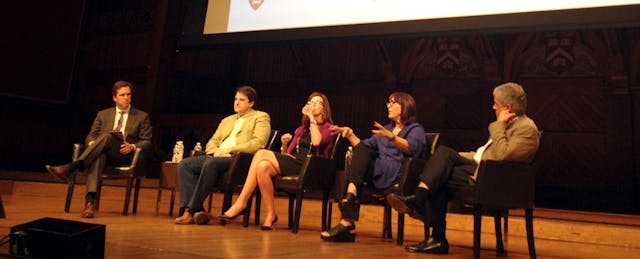“Education is not an American problem; it is a human problem,” said Lynda Weinman, co-founder of Lynda.com. And this global, timeless problem drew 600 education leaders from around the world to the 140-year-old Memorial Hall at Harvard University, one of the most venerable bastions of learning.
Organized by Goldman Sachs, the Global Education Conference was held for the first time this year on the East Coast; the previous two sessions were at Stanford University. During the one-and-a-half-day conference, discussions tackled how to best promote quality education across the globe through emerging media and technologies.
Why Global Education Matters
“Education around the world faces the same set of challenges,” said Geoffrey Canada, Founder and Chairman of Harlem Children’s Zone, in his opening keynote. Participants from Asia, Africa, Latin America and Europe shared their efforts in promoting innovative education practices in their hometowns.
In Singapore, Duke-National University of Singapore Medical School has implemented flipped classroom and collaborative learning. Yale-NUS College, a liberal arts college, is creating a whole new international experience for students.
China has 200 million K-12 students and 40% of family income is invested in education. 17zuoye (the name translates to “Homework together”) is an innovator in the Chinese K-12 space and as its name suggests, creates an online collaborative space for teachers, parents and students to do homework together.
“Africa is the last billion people to join the middle class,” said Karan Khemka, Education Practice Co-Head of The Parthenon Group. With 40% of all instruction lost due to teacher absenteeism, Bridge International Academies is using a scale-focused, data-driven, and technology-enabled Academy-in-a-Box solution to provide quality education to poverty-stricken kids. Meanwhile, Spire is working with Kenyan companies to build a new education-to-employment model.
For-Profit and Non-Profit Is A False Dichotomy
Where should the money to support such education ventures come from? The issue generated lots of discussion, but there was a general consensus among most speakers: the debate between “for-profit” and nonprofit” poses a false dichotomy when both models can be beneficial to help improve learning outcomes.
While critics have raised the point that for-profit companies are driven primarily by obligations to maximize revenue and meet shareholders’ values, Paul LeBlanc, President of Southern New Hampshire University, said for-profits must also do a good job in delivering the brand’s mission and service, since that is what shareholders are also investing in. This, he argued, is a powerful impetus driving companies to focus first and foremost on satisfying the needs of their customers and users.
The speakers suggested the market can support even more for-profit companies and startups, even though there has been a significant capital inflow into the education technology market in recent years. According to George Lee, Co-Chairman of Global TMT and CIO of Investment Banking at Goldman Sachs, in 2013, investments in edtech hit $1.25 billion across 378 deals and year-over-year deal activity rose 35%. However, the edtech market is still seriously underfunded. Jon Sakoda from New Enterprise Association said that investment in edtech is only at 1-3% of total venture funding across all industries, despite the fact that the current edtech market has already grown to $4-6 trillion dollars.
When asked about whether there will be an iconic company in the edtech space, like Google and Facebook, Sakoda thought that the current education market needs more time to take in and absorb the technologies, and there might not be one for another seven or eight years.
What Technology Can and Cannot Do
Technology is not the panacea to all education problems, but can enable changes in significant ways. The conference spotlighted a growing number of pioneers in the learning analytics and computer-adaptive learning space, such as Knewton and Renaissance Learning, which use data to understand how students learn. Clever was praised for creating instant logins that help schools and classrooms reclaim instruction time wasted on basic setup and logistics.
“Universities are usually frozen, but education should not,” said Peter Bol, Vice Provost for Advances in Learning at Harvard University. MOOCs, most agreed, are valuable in being able to reduce time and space restrictions in higher education. ChinaX is a popular MOOC on Chinese history (in all its 2,000-plus year glory) that spans 10 months long, which would be difficult to fit within a traditional university schedule.
At the same time, technology needs to come with pedagogy and systemic reform in a holistic way, said John Fallon, CEO of Pearson, who is trying to unite products and services to build more open, interoperable education “ecosystems” centered around learners. In this holistic system, teachers and professional development play a significant role, as Martin Bean from Open University expressed, and instructional design comes before technology. Kimberly Oliver, the 2006 National Teacher of the Year, said that technology in the classroom is useless unless we teach teachers how to use it.
In the end, attendees saw technological innovation not as a magical formula, but instead focused on its alignment with the mission and delivery of improving student outcome. “Innovate not for the sake of innovation,” reminded Bill Goodwyn, CEO of Discovery Education.


